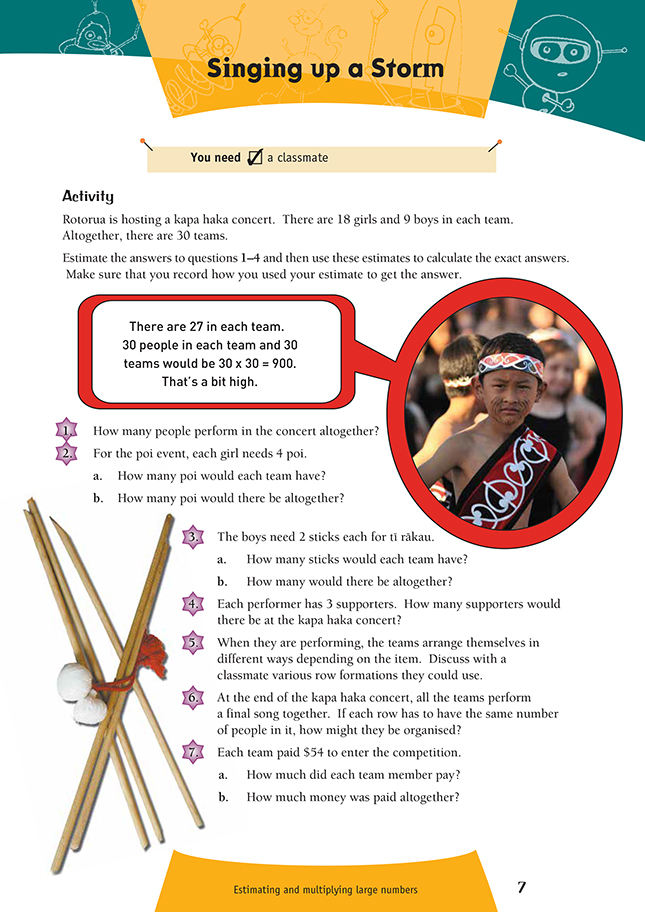This is a level 3 number activity from the Figure It Out series. It relates to Stage 6 of the Number Framework.
A PDF of the student activity is available.
Click on the image to enlarge it. Click again to close. Download PDF (241KB)
solve problems involving multiplication and division facts
FIO, Level 3, Number, Book 2, Singing up a Storm, page 7
A classmate
This activity encourages estimation strategies as well as exact multiplication. Ask the students to do the estimations mentally before they calculate the exact multiplications with pencil and paper.
Use the speech bubble as a model and have the students discuss two or three estimation strategies before the exact answer is calculated.
The think, pair, and share technique is a good way of encouraging the mental strategies. The students could be given 30 seconds to estimate on their own, then they share their estimates and strategy with a classmate, and finally, some pairs share back with the whole group.
For question 5, the students could use two colours of counters: 9 of one colour for the boys and 18 of another for the girls. They could then experiment with different ways of arranging the team of 27 using the counters. 1 and 27 and 3 and 9 are factors of 27, so a team could be arranged in rows of 1, 3, 9, or 27.
Have the students try to describe their arrangement using numbers as well as words. Encourage them to think about symmetry as they arrange their teams. For example, an arrangement such as:
B G G B G G B G G
B G G B G G B G G
B G G B G G B G G
has translation symmetry and could be described as columns of 1 x 3 boys + 2 x 3 girls, repeated 3 times.
An arrangement such as:
B G G G B G G G B
B G G G B G G G B
B G G G B G G G B
has reflective symmetry and could be described as columns of 1 x 3 boys and 3 x 3 girls, repeated twice, with a final column of 1 x 3 boys.
Question 6 explores all the combinations of 2 factors that make the product 810. Encourage the students to record systematically so that they do not miss some possible combinations. It may help to have the students examine the number 810 to see what hints it gives about the factors. Statements such as these would be useful:
“It’s an even number, so it must be 2 x ”
“It ends in 0, so it must have a 10 x as well as a 5 x .”
“It’s got 81 tens, so it must have 9 x as well as 3 x and 27 x .”
Although all the combinations are asked for, the students may wish to eliminate some of the possibilities by using logical thinking. For example, it is unlikely that the venue could fit the 1 x 810 option or even the 2 x 405 option.
Answers to Activity
1. 810. (An estimate could be: 18 + 9 is about 30. 30 x 30 = 900, but there are 3 less than 30 in each team, so a sensible estimate would be 800. 900 – [3 x 30] = 810)
2. a. 72. (An estimate could be: 20 x 4 = 80. 80 – [4 x 2] = 72)
b. 2 160. (An estimate could be: 70 x 30 = 2 100. 2 100 + [30 x 2] = 2 160.
Or you could work out the number of girls [18 x 30 = 540] and double that number
twice: 540 x 2 x 2 = 2 160.)
3. a. 18. (An estimate could be: 10 x 2 = 20. 20 – 2 = 18. But you should probably know 9 x 2 = 18.)
b. 540. (An estimate could be: 20 x 30 = 600. 600 – [2 x 30] = 540)
4. 2 430. (800 [the estimate] x 3 = 2 400. But the actual number is 810, so
2 400 + [3 x 10] = 2 430.)
5. Answers will vary.
6. There are 20 possible ways:
1 x 810, 2 x 405, 3 x 270, 5 x 162, 6 x 135, 9 x 90, 10 x 81, 15 x 54, 18 x 45, 27 x 30, 30 x 27, 45 x 18, 54 x 15, 81 x 10, 90 x 9, 135 x 6, 162 x 5, 270 x 3, 405 x 2, 810 x 1
7. a. $2.00
b. $1,620. ([50 x 30] + [4 x 30] = 1 620)
